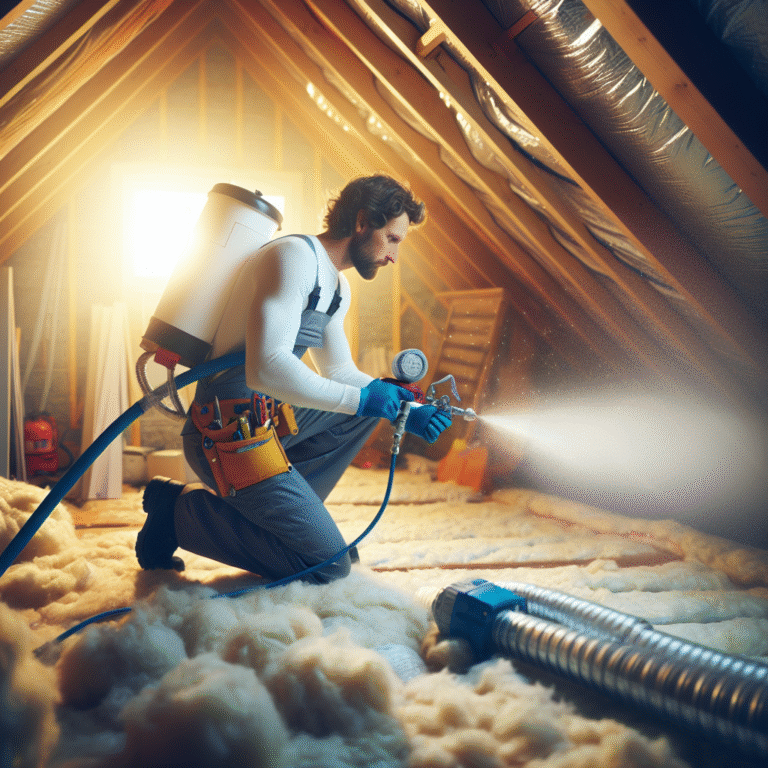-
Table of Contents
“Maximize your home’s comfort and savings with Blown-In Insulation – the cost-effective solution for long-term benefits.”
“Discover the cost-effective benefits of blown-in insulation for your home today! Visit texasinsulationsolution.com to learn more and schedule your installation. Don’t miss out on the energy savings and comfort that blown-in insulation can provide. Contact us now!”
Introduction
Blown-in insulation is a popular method of insulating homes and buildings, providing numerous benefits such as improved energy efficiency and cost savings. This type of insulation involves blowing loose fibers or particles into walls, attics, and other spaces to create a barrier against heat transfer. While the initial cost of blown-in insulation may be higher than other insulation methods, the long-term benefits make it a worthwhile investment for homeowners and businesses. In this article, we will explore the cost and benefits of blown-in insulation to help you make an informed decision for your insulation needs.
The Cost-Effective Benefits of Blown-In Insulation for Your Attic Savings
Blown-in insulation is a popular choice for homeowners looking to improve the energy efficiency of their homes. It involves using a machine to blow loose insulation material, such as fiberglass or cellulose, into the attic space. This method of insulation has gained popularity due to its cost-effectiveness and numerous benefits.
One of the main benefits of blown-in insulation is its cost-effectiveness. Compared to other types of insulation, such as batt or spray foam, blown-in insulation is relatively inexpensive. This is because it requires less labor and materials to install. The loose insulation material can be easily blown into tight spaces and around obstacles, making it a quick and efficient process. This means that homeowners can save on installation costs and still achieve the same level of insulation as other methods.
In addition to being cost-effective, blown-in insulation also offers significant savings in terms of energy bills. By properly insulating your attic, you can prevent heat from escaping during the winter and keep cool air in during the summer. This means that your heating and cooling systems will not have to work as hard to maintain a comfortable temperature, resulting in lower energy bills. In fact, according to the Department of Energy, homeowners can save up to 20% on their heating and cooling costs by properly insulating their attics.
Another benefit of blown-in insulation is its ability to provide better coverage and reduce air leakage. Unlike batt insulation, which can leave gaps and spaces between the insulation and the attic, blown-in insulation fills in all the nooks and crannies, providing a more complete and thorough coverage. This helps to reduce air leakage, which can account for up to 30% of a home’s heating and cooling costs. By reducing air leakage, blown-in insulation can help to create a more comfortable and consistent temperature throughout the home.
Furthermore, blown-in insulation is also a more environmentally friendly option compared to other types of insulation. The loose insulation material is often made from recycled materials, such as shredded newspaper or recycled glass, making it a sustainable choice. Additionally, the installation process of blown-in insulation produces less waste compared to other methods, making it a more eco-friendly option for homeowners.
Aside from its cost-effectiveness and energy-saving benefits, blown-in insulation also offers other advantages. For instance, it can help to reduce noise levels in the home. The dense and compact nature of blown-in insulation can act as a sound barrier, reducing outside noise from entering the home and vice versa. This can be especially beneficial for homeowners living in noisy neighborhoods or near busy roads.
Moreover, blown-in insulation can also improve the overall comfort of your home. By properly insulating your attic, you can prevent drafts and cold spots, making your home more comfortable and enjoyable to live in. This can be particularly beneficial during extreme weather conditions, as the insulation can help to maintain a consistent temperature throughout the home.
In conclusion, blown-in insulation offers numerous cost-effective benefits for homeowners. From its affordability and energy-saving capabilities to its eco-friendliness and overall comfort, it is a practical and efficient choice for insulating your attic. By investing in blown-in insulation, homeowners can not only save on their energy bills but also improve the overall quality of their homes. So, if you are looking to improve the energy efficiency of your home, consider blown-in insulation as a cost-effective and beneficial option.
Maximizing Your Attic Savings with Blown-In Insulation: A Cost Analysis
Blown-in insulation has become a popular choice for homeowners looking to improve the energy efficiency of their homes. This type of insulation involves using a machine to blow loose insulation material, such as fiberglass or cellulose, into the attic space. It is a quick and easy process that can provide significant benefits, but it also comes with a cost. In this article, we will explore the cost versus benefit analysis of blown-in insulation and how it can help you maximize your attic savings.
The first factor to consider when looking at the cost of blown-in insulation is the initial investment. The cost of materials and installation can vary depending on the size of your attic and the type of insulation used. On average, blown-in insulation can cost anywhere from $1 to $3 per square foot. This may seem like a significant expense, but it is important to remember that this is a one-time cost that can provide long-term benefits.
One of the main benefits of blown-in insulation is its ability to improve energy efficiency. By filling in any gaps or spaces in your attic, it can prevent heat from escaping during the winter and keep cool air in during the summer. This can result in lower energy bills and ultimately save you money in the long run. In fact, according to the Department of Energy, homeowners can save up to 20% on their heating and cooling costs by properly insulating their attics.
Another benefit of blown-in insulation is its ability to reduce noise. The loose material can absorb sound waves, making your home quieter and more comfortable. This is especially beneficial for those living in noisy areas or near busy roads. Additionally, blown-in insulation is known for its fire-resistant properties, providing an extra layer of protection for your home.
When it comes to the cost versus benefit analysis, it is also important to consider the potential savings on maintenance and repairs. By properly insulating your attic, you can prevent moisture from entering your home, which can lead to mold and mildew growth. This can save you from costly repairs and potential health hazards. Furthermore, blown-in insulation can also help extend the lifespan of your HVAC system by reducing the strain on it, resulting in fewer repairs and replacements.
In addition to the financial benefits, blown-in insulation can also have a positive impact on the environment. By reducing your energy consumption, you are also reducing your carbon footprint. This can help contribute to a more sustainable future and make a positive impact on the planet.
While the benefits of blown-in insulation are clear, it is important to also consider the potential drawbacks. One of the main concerns is the possibility of settling. Over time, the loose material may settle and compress, reducing its effectiveness. However, this can be easily remedied by adding more insulation as needed.
Another factor to consider is the potential for damage during installation. If not done properly, blown-in insulation can cause damage to electrical wiring or recessed lighting in the attic. It is important to hire a professional and experienced contractor to ensure proper installation and avoid any potential hazards.
In conclusion, blown-in insulation can provide numerous benefits for homeowners, including improved energy efficiency, noise reduction, and potential savings on maintenance and repairs. While there is an initial cost involved, the long-term benefits far outweigh the investment. It is important to carefully consider the cost versus benefit analysis and consult with a professional before making a decision. With proper installation and maintenance, blown-in insulation can help you maximize your attic savings and create a more comfortable and energy-efficient home.
Is Blown-In Insulation Worth the Cost? Examining the Benefits for Your Attic Savings
Blown-in insulation has become a popular choice for homeowners looking to improve the energy efficiency of their homes. This type of insulation involves using a machine to blow loose insulation material, such as fiberglass or cellulose, into the attic space. It is a quick and easy process that can provide numerous benefits, but many homeowners are hesitant due to the cost. In this article, we will examine the cost versus benefits of blown-in insulation and determine if it is worth the investment for your attic savings.
First and foremost, let’s address the cost of blown-in insulation. The initial cost of blown-in insulation may be higher than traditional insulation methods, such as batt or roll insulation. This is because it requires specialized equipment and trained professionals to install it properly. However, it is important to consider the long-term savings that blown-in insulation can provide.
One of the main benefits of blown-in insulation is its ability to create a more airtight seal in your attic. This means that less air will escape from your home, resulting in lower energy bills. In fact, according to the Department of Energy, blown-in insulation can save homeowners up to 20% on their heating and cooling costs. This means that the initial cost of blown-in insulation can be recouped over time through these energy savings.
Another benefit of blown-in insulation is its ability to fill in small gaps and crevices in your attic. This is especially important for older homes that may have settled over time, creating gaps in the traditional insulation. These small gaps can allow air to escape, reducing the effectiveness of your insulation and driving up your energy costs. Blown-in insulation can easily fill in these gaps, creating a more efficient barrier against air leakage.
In addition to energy savings, blown-in insulation can also improve the overall comfort of your home. By creating a more airtight seal, it can help regulate the temperature in your home, making it more comfortable year-round. This is especially beneficial for homes in extreme climates, where the temperature can fluctuate drastically. With blown-in insulation, you can enjoy a more consistent and comfortable temperature in your home without constantly adjusting your thermostat.
Furthermore, blown-in insulation can also provide soundproofing benefits. The loose material can absorb sound waves, reducing noise from outside sources such as traffic or neighbors. This can be particularly beneficial for homes located in busy areas or near airports. It can also help create a quieter and more peaceful living environment for you and your family.
Another factor to consider when examining the cost versus benefits of blown-in insulation is its longevity. Unlike traditional insulation, which can compress and lose its effectiveness over time, blown-in insulation maintains its shape and density. This means that it will continue to provide the same level of insulation for many years to come, without the need for replacement or additional insulation.
In conclusion, while the initial cost of blown-in insulation may be higher than traditional methods, the long-term benefits far outweigh the investment. From energy savings to improved comfort and soundproofing, blown-in insulation can provide numerous advantages for your attic and overall home. It is a worthwhile investment that can not only save you money in the long run but also improve the overall quality of your living space. So, if you are considering upgrading your attic insulation, blown-in insulation is definitely worth the cost for the benefits it can provide.
Q&A
1. What is the average cost of blown-in insulation installation?
The average cost of blown-in insulation installation can vary depending on factors such as the size of the area to be insulated, the type of insulation material used, and the location of the property. However, on average, homeowners can expect to pay between $1,500 to $2,500 for blown-in insulation installation.
2. What are the benefits of blown-in insulation?
Blown-in insulation offers several benefits, including improved energy efficiency, reduced utility bills, and increased comfort in the home. It also helps to reduce noise levels and can improve indoor air quality by preventing drafts and air leaks.
3. Is blown-in insulation worth the cost?
In most cases, blown-in insulation is worth the cost as it can provide long-term savings on energy bills and improve the overall comfort of a home. Additionally, blown-in insulation is a relatively affordable and efficient way to insulate a property, making it a worthwhile investment for many homeowners.
Conclusion
In conclusion, blown-in insulation can be a cost-effective option for improving energy efficiency and reducing utility costs in a home. While the initial cost may be higher than traditional insulation methods, the long-term benefits of lower energy bills and increased comfort make it a worthwhile investment. Additionally, blown-in insulation can also help reduce carbon footprint and contribute to a more sustainable environment. It is important to carefully consider the cost and benefits of blown-in insulation and consult with a professional to determine the best option for your specific needs and budget.




